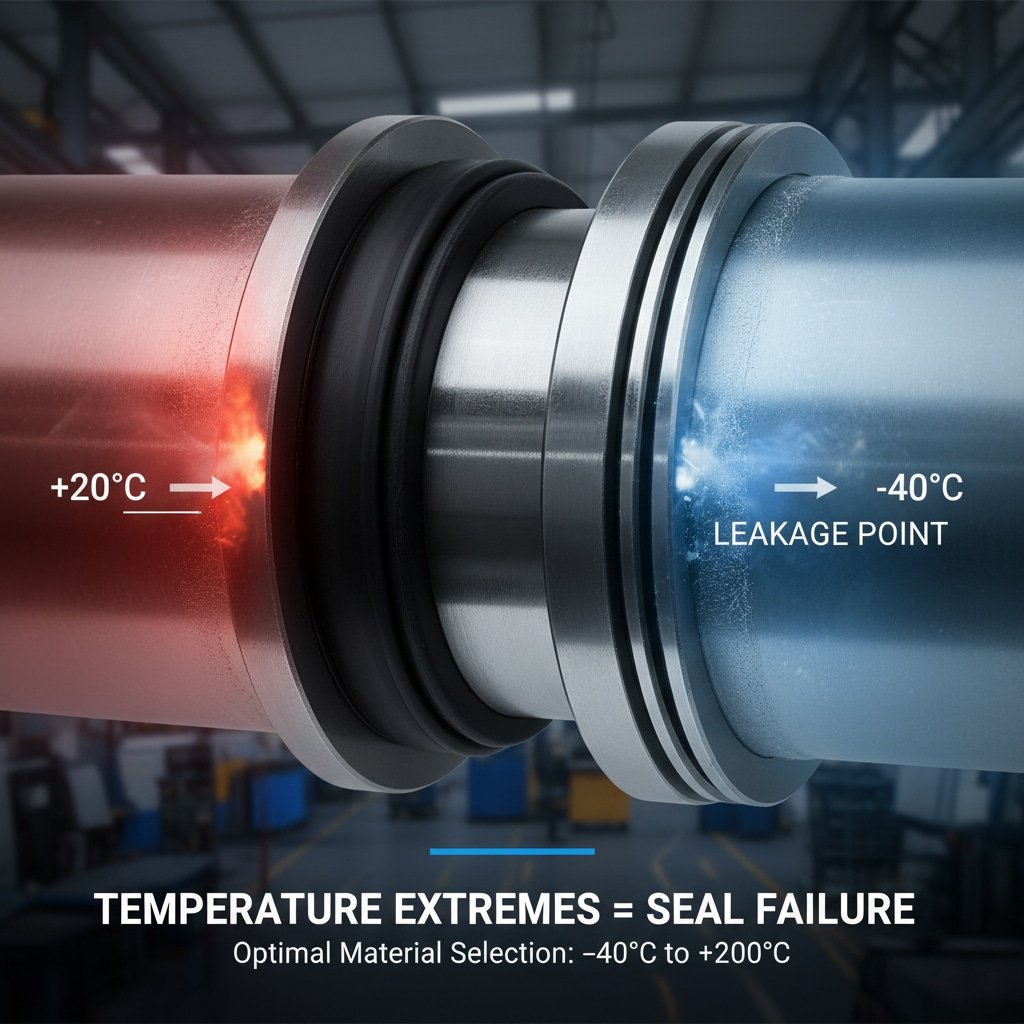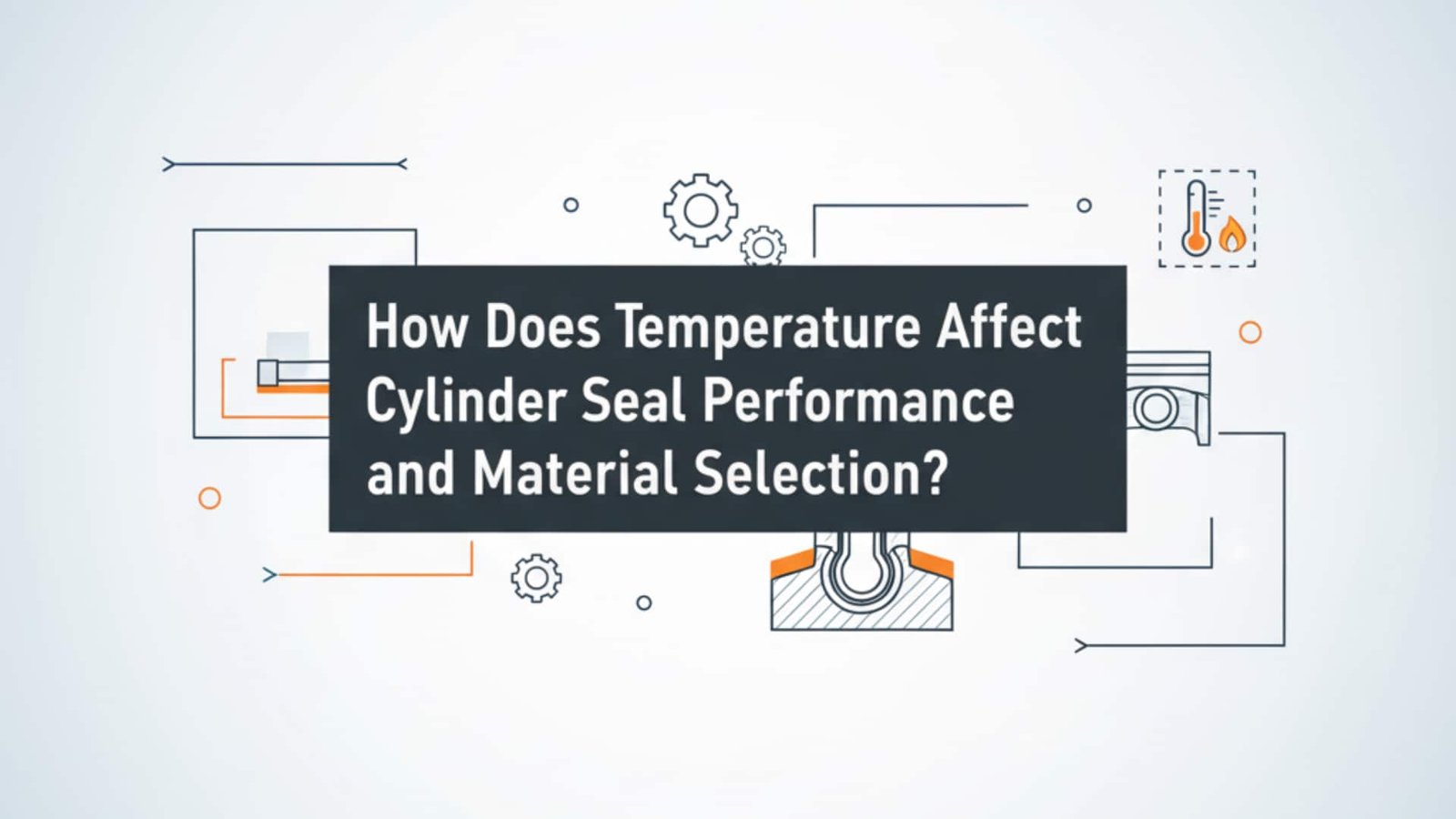
Industrial operations face catastrophic seal failures when temperature extremes compromise cylinder performance, with 84% of premature seal failures occurring in applications operating outside optimal temperature ranges, leading to costly downtime and safety hazards. 🌡️
Temperaturen påvirker sylindertetningenes ytelse direkte gjennom materialutvidelse, endringer i hardhet og kjemisk nedbrytning, og riktig materialvalg muliggjør pålitelig drift fra -40 °C til +200 °C, samtidig som lekkasjetettheten opprettholdes og levetiden forlenges.
Yesterday, I helped Marcus, a process engineer from Minnesota, whose outdoor packaging equipment was experiencing daily seal failures during winter operations at -30°C because standard seals couldn’t handle the extreme cold conditions. ❄️
Innholdsfortegnelse
- What Temperature Effects Impact Cylinder Seal Performance?
- How Do Different Seal Materials Perform Across Temperature Ranges?
- Which Applications Require Special Temperature-Resistant Sealing Solutions?
- Why Do Bepto Temperature-Optimized Seals Outperform Standard Options?
What Temperature Effects Impact Cylinder Seal Performance?
Understanding how temperature affects seal materials reveals why proper selection is critical for reliable cylinder operation across diverse environments.
Temperature impacts seal performance through termisk ekspansjon1 affecting compression, material hardness changes altering sealing force, chemical degradation reducing elastomer properties, and dimensional stability affecting groove fit and sealing effectiveness.

Primary Temperature Effects
Thermal Expansion:
- Seal growth: Materials expand with heat, potentially causing binding
- Groove clearance: Cold temperatures create gaps, reducing sealing force
- Differensiell ekspansjon: Ulike materialer utvider seg i ulik hastighet
- Spenningskonsentrasjon: Thermal cycling creates fatigue points
Material Property Changes:
- Hardness variation: Cold makes seals brittle, heat makes them soft
- Elasticity loss: Extreme temperatures reduce spring-back ability
- Kompresjonssett2: Permanent deformation under temperature stress
- Tear resistance: Temperature affects material strength
Temperature Failure Modes
| Temperaturområde | Primær feilmodus | Typiske symptomer | Service Life Impact |
|---|---|---|---|
| Below -20°C | Brittleness, cracking | Sudden leakage | 70% reduksjon |
| -20 °C til +80 °C | Normal slitasje | Gradual degradation | Normal life |
| +80°C to +150°C | Fremskyndet aldring | Hardening, shrinkage | 50% reduksjon |
| Above +150°C | Chemical breakdown | Complete failure | 90% reduksjon |
Critical Temperature Thresholds
Low Temperature Limits:
- Glass transition3: Material becomes brittle
- Crystallization: Loss of elasticity
- Shrinkage: Reduced sealing contact
- Embrittlement: Crack initiation
High Temperature Limits:
- Thermal degradation: Chemical breakdown
- Oksidasjon: Material deterioration
- Plasticizer loss: Hardening and shrinkage
- Compression set: Permanent deformasjon
Marcus’s situation illustrates low-temperature challenges perfectly – his standard NBR seals were operating below their glass transition temperature, becoming brittle and cracking within hours of exposure to -30°C conditions. 🥶
How Do Different Seal Materials Perform Across Temperature Ranges?
Seal material selection determines operational temperature range and performance characteristics under thermal stress conditions.
Different seal materials offer distinct temperature capabilities, with NBR4 suitable for -30°C to +100°C, FKM (Viton)5 performing from -20°C to +200°C, and specialized compounds like FFKM enabling operation from -40°C to +300°C for extreme applications.

Material Temperature Comparison
| Materiale | Low Temp Limit | High Temp Limit | Optimal rekkevidde | Kostnadsfaktor |
|---|---|---|---|---|
| NBR (nitril) | -30°C | +100°C | -10 °C til +80 °C | 1.0x |
| HNBR | -40°C | +150°C | -20°C to +130°C | 2.5x |
| FKM (Viton) | -20°C | +200°C | 0°C to +180°C | 4.0x |
| EPDM | -45°C | +150°C | -30°C to +120°C | 1.8x |
| FFKM (Kalrez) | -40°C | +300°C | -20°C to +250°C | 15.0x |
Ytelsesegenskaper
NBR (Nitrile Rubber):
- Fordeler: Cost-effective, good oil resistance, wide availability
- Begrensninger: Limited high-temperature capability, poor ozone resistance
- Bruksområder: General industrial, moderate temperature ranges
- Temperature behavior: Hardens significantly below -20°C
FKM (Fluoroelastomer):
- Fordeler: Excellent chemical resistance, high-temperature capability
- Begrensninger: Higher cost, limited low-temperature flexibility
- Bruksområder: Chemical processing, high-temperature environments
- Temperature behavior: Vedlikeholder egenskaper over et bredt spekter
HNBR (Hydrogenated Nitrile):
- Fordeler: Enhanced temperature range, better ozone resistance
- Begrensninger: Higher cost than standard NBR
- Bruksområder: Automotive, outdoor equipment, temperature cycling
- Temperature behavior: Improved low-temperature flexibility
Applikasjonsspesifikt utvalg
Cold Environment Applications:
- Outdoor equipment: HNBR or EPDM for flexibility
- Refrigeration: Specialized low-temperature compounds
- Arctic operations: Custom formulations for extreme cold
- Termisk sykling: Materials resistant to fatigue
High-Temperature Applications:
- Heat treatment: FKM for sustained high temperatures
- Engine applications: HNBR for automotive environments
- Kjemisk prosessering: FFKM for extreme conditions
- Steam applications: Specialized high-temperature elastomers
Material Selection Guidelines
Tenk på disse faktorene:
- Operating temperature range: Continuous vs. intermittent exposure
- Kjemisk kompatibilitet: Media contact requirements
- Krav til trykk: High pressure needs harder materials
- Dynamic vs. static: Movement affects material choice
- Cost considerations: Balance performance vs. economics
At Bepto, we stock temperature-optimized seals for every application, from Arctic outdoor equipment to high-temperature industrial processes. 🌡️
Which Applications Require Special Temperature-Resistant Sealing Solutions?
Specific industrial environments demand specialized sealing solutions to handle extreme temperature conditions and thermal cycling.
Applications requiring temperature-resistant seals include outdoor equipment exposed to weather extremes, high-temperature manufacturing processes, food processing with steam cleaning, and mobile equipment operating across seasonal temperature variations.
Extreme Environment Applications
Cold Weather Operations:
- Construction equipment: -40°C to +40°C seasonal variation
- Agricultural machinery: Outdoor storage and operation
- Mining equipment: Underground and surface temperature extremes
- Transportation: Refrigerated trucks and cold storage
High-Temperature Processes:
- Steel manufacturing: Furnace and hot rolling operations
- Glass production: High-temperature forming processes
- Kjemisk prosessering: Reactor and distillation equipment
- Matforedling: Steam cleaning and sterilization
Applikasjonsspesifikke krav
| Søknad | Temperaturområde | Spesielle krav | Recommended Material |
|---|---|---|---|
| Outdoor construction | -30°C to +60°C | UV resistance, flexibility | HNBR |
| Matforedling | +5°C to +140°C | FDA compliance, steam | FKM |
| Chemical plant | -10°C to +180°C | Kjemisk resistens | FKM/FFKM |
| Mobilt utstyr | -40 °C til +80 °C | Dynamic sealing | HNBR |
Thermal Cycling Challenges
Daily Temperature Cycles:
- Expansion/contraction: Materials must accommodate movement
- Motstandsdyktighet mot utmattelse: Repeated stress cycles
- Dimensjonell stabilitet: Maintaining seal integrity
- Groove design: Accommodating thermal growth
Seasonal Variations:
- Long-term exposure: Extended temperature extremes
- Storage conditions: Off-season temperature effects
- Start-up performance: Cold weather operation
- Material aging: Temperature-accelerated degradation
Suksesshistorier
Arctic Mining Operation:
Lisa, an equipment manager from Alaska, was losing $50,000 per week due to seal failures in -45°C conditions. Our specialized HNBR seals with low-temperature additives eliminated failures and extended service intervals from weekly to quarterly maintenance. ⛄
Steel Mill Application:
A steel processing plant needed cylinders operating near 200°C furnaces. Standard seals lasted only days before hardening and cracking. Our FKM seal solution provided 6-month service life with consistent performance throughout the temperature range.
Designhensyn
Groove Design:
- Thermal expansion clearance: Account for material growth
- Backup ring support: Prevent extrusion at high temperatures
- Overflatebehandling: Critical for high-temperature sealing
- Installation clearances: Allow for thermal effects
Systemintegrasjon:
- Cooling provisions: Heat management for extreme applications
- Insulation: Protecting seals from radiant heat
- Ventilation: Preventing heat buildup
- Monitoring: Temperature sensing for preventive maintenance
Our engineering team provides complete thermal analysis and seal selection for the most challenging temperature environments. 🔥
Why Do Bepto Temperature-Optimized Seals Outperform Standard Options?
Our advanced seal technology and material selection deliver superior performance across extreme temperature ranges through specialized engineering.
Bepto temperature-optimized seals outperform standard options through custom material formulations, precision manufacturing tolerances, advanced groove designs, and comprehensive testing that ensures reliable operation across -40°C to +200°C temperature ranges.
Avansert materialteknologi
Custom Formulations:
- Low-temperature plasticizers: Maintain flexibility in cold
- High-temperature stabilizers: Prevent degradation
- Antioxidants: Reduce thermal aging
- Reinforcement: Forbedret holdbarhet
Kvalitetssikring:
- Temperature cycling tests: Validate performance ranges
- Accelerated aging: Predict long-term behavior
- Material certification: Documented properties
- Batch testing: Consistent quality control
Fordeler med ytelse
| Funksjon | Standard Seals | Bepto Optimized | Forbedring |
|---|---|---|---|
| Temperaturområde | -20 °C til +80 °C | -40 °C til +150 °C | 100% wider |
| Levetid | 6 måneder | 18+ months | 200% lengre |
| Termisk sykling | 1,000 cycles | 5,000+ cycles | 400% bedre |
| Leak rate | 5 cc/min | <1 cc/min | 80% reduksjon |
Fremragende ingeniørkunst
Presisjonsproduksjon:
- Dimensional accuracy: ±0.05mm tolerances
- Surface quality: Optimized for sealing
- Material consistency: Uniform properties
- Quality documentation: Full traceability
Application Support:
- Temperature analysis: Operating condition assessment
- Valg av materiale: Optimal compound choice
- Installation guidance: Proper assembly procedures
- Overvåking av ytelse: Løpende støtte
Kost-nytte-analyse
While Bepto temperature-optimized seals may cost 20-40% more initially, the total value proposition is compelling:
- Extended service life: 200-400% longer operation
- Redusert nedetid: Fewer emergency repairs
- Lower maintenance costs: Less frequent replacement
- Improved reliability: Konsekvent ytelse
Customer Success
Our temperature-optimized solutions have delivered remarkable results:
- 95% reduksjon in cold-weather seal failures
- 300% økning in high-temperature service life
- 80% decrease i akutte vedlikeholdsbesøk
- 50% reduksjon in total sealing costs
Teknisk støtte
We provide comprehensive support including:
- Application engineering: Custom solution development
- Temperature testing: Validation of performance
- Opplæring i installasjon: Proper assembly techniques
- Overvåking av ytelse: Ongoing optimization
Konklusjon
Temperature significantly impacts cylinder seal performance, making proper material selection and seal design critical for reliable operation across diverse environmental conditions. 🎯
FAQs About Temperature and Cylinder Seals
Q: What temperature range can standard cylinder seals handle reliably?
Standard NBR seals typically operate reliably from -20°C to +80°C, but performance degrades rapidly outside this range. For extreme temperatures, specialized materials like HNBR (-40°C to +150°C) or FKM (-20°C to +200°C) provide much better performance and longer service life.
Q: How do I know if temperature is causing my seal failures?
Temperature-related failures show specific symptoms: brittleness and cracking in cold conditions, hardening and shrinkage in heat, or rapid degradation with temperature cycling. If failures correlate with temperature extremes or seasonal changes, temperature is likely the root cause.
Q: Can I upgrade existing cylinders with better temperature-resistant seals?
Yes, most cylinders can be upgraded with temperature-optimized seals without design changes. We analyze your operating conditions and recommend the best seal material and design for your specific temperature requirements, often extending service life by 200-400%.
Q: What’s the cost difference between standard and temperature-resistant seals?
Temperature-resistant seals typically cost 20-50% more initially, but deliver 200-400% longer service life and dramatically reduce downtime costs. The total cost of ownership is usually 30-60% lower due to extended replacement intervals and improved reliability.
Q: How do Bepto seals perform compared to OEM temperature-rated seals?
Bepto temperature-optimized seals often exceed OEM specifications through advanced materials and precision manufacturing. We typically provide 50-100% wider temperature ranges, 200% longer service life, and better resistance to thermal cycling compared to standard OEM seals.
-
Learn about the principle of thermal expansion and how it affects different materials. ↩
-
Understand the concept of compression set and why it’s a critical property for sealing materials. ↩
-
Explore the science behind the glass transition temperature and why it’s crucial for low-temperature applications. ↩
-
Discover the properties, advantages, and limitations of NBR (Nitrile Rubber) as a common seal material. ↩
-
Learn more about FKM (Viton) fluoroelastomers and their high-performance characteristics. ↩


